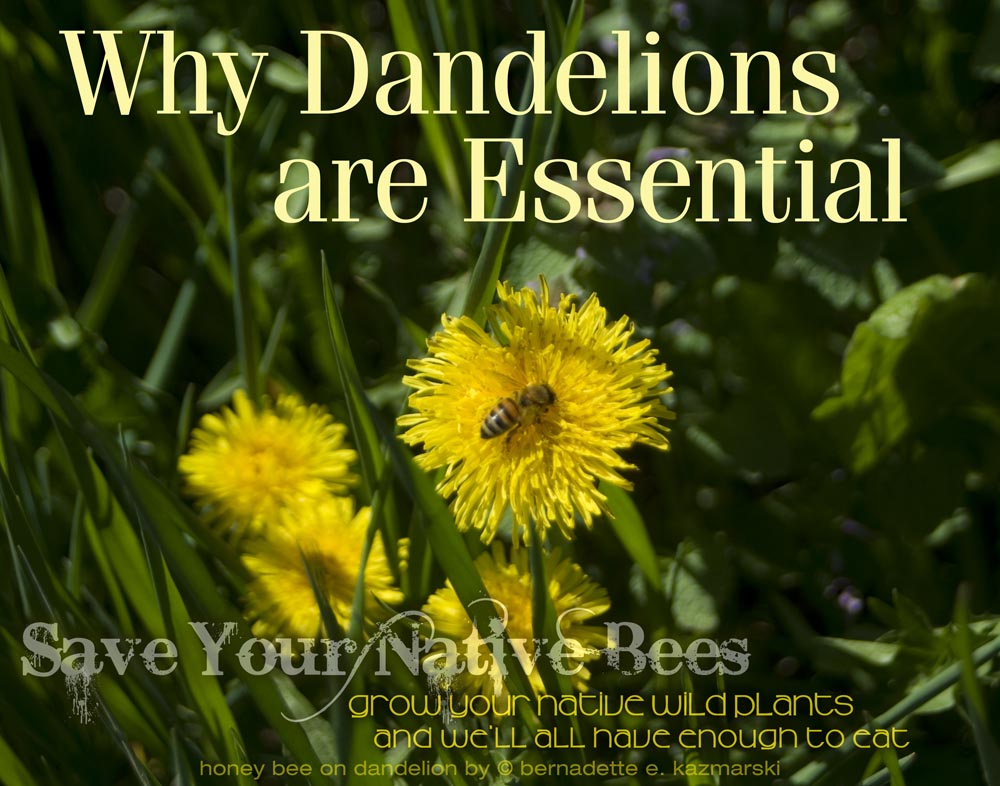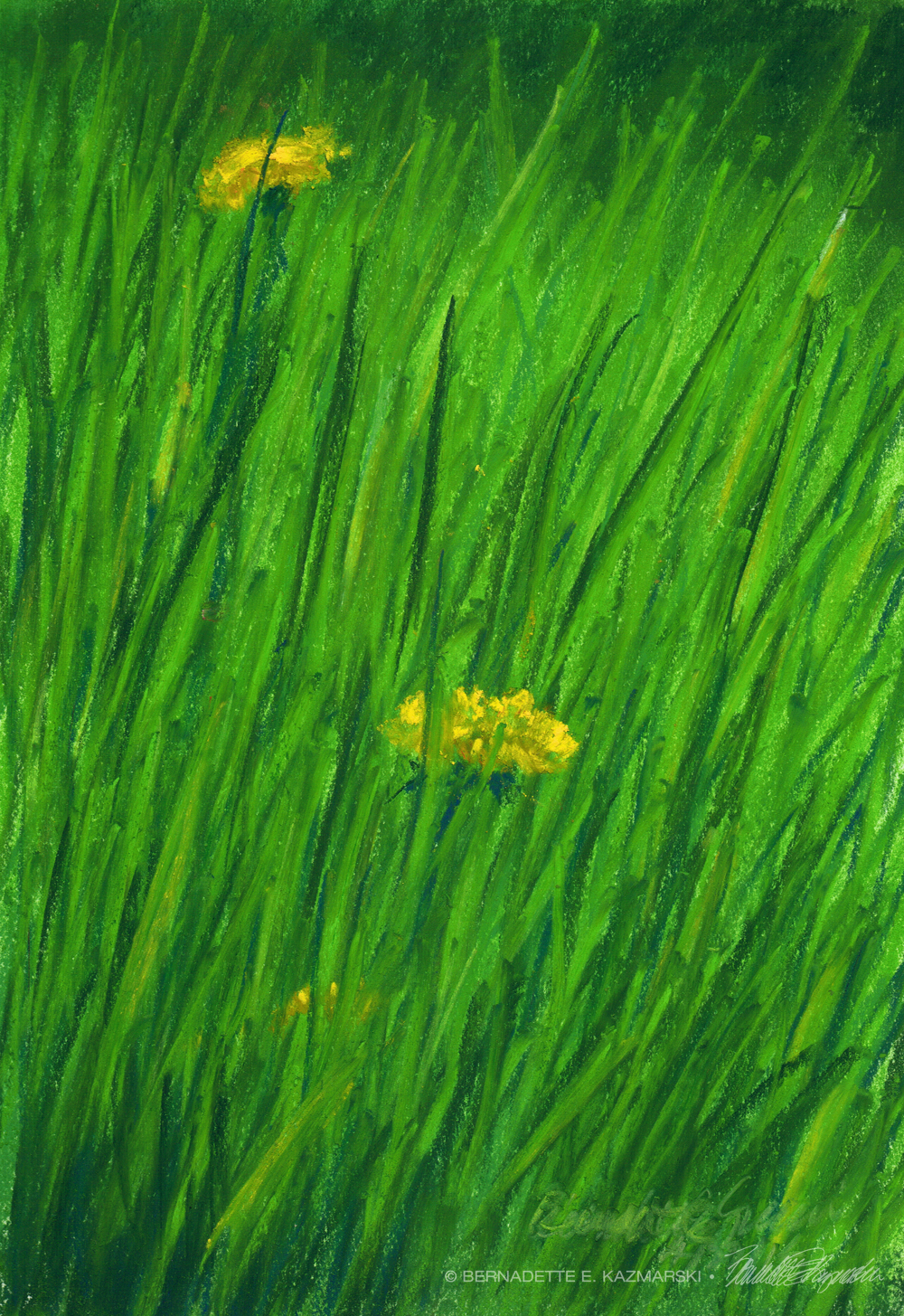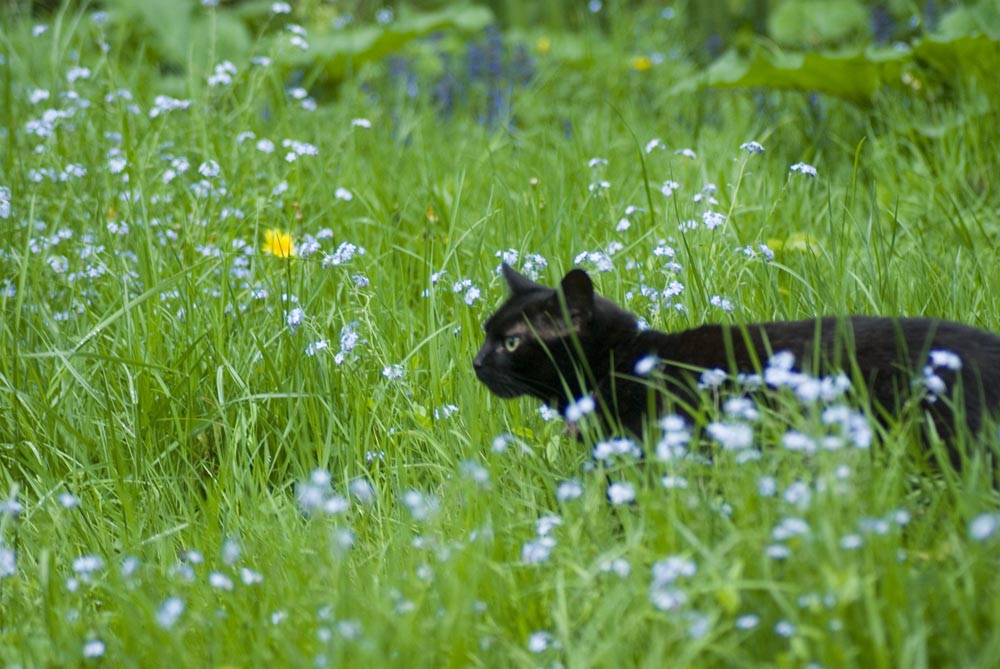Your Backyard Wildlife Habitat: Why Dandelions Are Essential

I POSTED THIS on my photo blog Today and it had a wonderful reception from readers. It occurred to me that the information here also applies to managing your backyard wildlife habitat as well as “Living Green With Pets” while keeping your yard healthy and pest-reduced without using toxic chemicals. Please feel free to right-click and download the image above, and spread this important message!
. . . . . . .
Help! Everything is sprouting and they aren’t necessarily plants you want growing in your yard! Time to pull and cut and chop and even spray chemicals to kill those things? Stop for a moment and consider—some of those things you really don’t want, some you do and don’t know it, and some don’t really matter, but there is one species that needs all those suddenly-sprouting native wild plants, especially the detested dandelion. Note that I said “needs”, not “likes” or “prefers”, and read on.
Bees are the most important overall pollinator on our planet. Local native insect species help to spread pollen from one flower to another in their native areas, but bee species exist worldwide wherever things bloom and grow and are by far the insects that pollinate most plants we depend on for food. Many species of bees are disappearing at alarming rates including the most familiar honey bees and bumble bees, and there is no one certain answer why they are. It’s found that pesticides are weakening their immune systems making them susceptible to parasites and pathogens, and at the same time, often as a result of the same chemicals, their natural food sources are disappearing, not those greenhouse annuals or non-native hybrids but your area’s native wildflowers in meadows over farms and greenspace.
What is one native plant that grows and survives just about everywhere in the world? Where else can a hungry honey bee find a meal early in the spring when nothing else is blooming? This little cluster of dandelions is a lifesaver for a bee with spring coming so late all over the country and many plants blooming even later, or not at all after a series of freezes. As the season continues and the profusion of spring flowers fades, what else is still reliably producing pollen to keep bees alive, and to actually lure them to your yard, orchard, fields?
Dandelions are native to all temperate areas of the planet and in that way are familiar to bees all over the planet, providing nectar and pollen as early as warmer temperatures awaken bees. Many other pollinating insects rely on them for a meal as well, such as butterflies, and despised as dandelions are they are important for attracting pollinators to gardens everywhere.
Dandelions are good for the garden as well. Their long tap roots break up hard soil and bring minerals up to the surface where plants with shorter roots can access them and in this way they help bring nitrogen to the roots of shallower plants. And as mentioned above they are a universal beacon for bees and other insects that will visit to pollinate your plants whether they be ornamental flowers or food.
Dandelions are good for people too, and from root to flower dandelions have been a staple in the human diet and healing pharmacy for as long as humans have been foraging. All those minerals the dandelion pulls up in that root and the vitamins that are locked into the leaves of any verdant plant, as nutritious as any cultivated cooking green we might grow like spinach, kale, chard or mustard greens, are in those pointy leaves for us to consume. The yellow flowers have been used to make a famous dandelion wine, and also a pale buttery yellow dye.
I just don’t understand the hatred of a pretty little yellow flower. I’m so glad to see them in the spring—sometimes they’ll actually bloom during the spring thaw, between the snows. I find them pretty inspiring for artwork as well.

So many chemicals are used to kill dandelions on lawns every year and this chemical use contributes to nonpoint source pollution of our waterways, the largest category of pollutants in the nation. Maintaining your lawn as a habitat and cutting your grass as tall as possible generally keeps them under control—I’ve never gone after the ones in my yard, never use any chemicals at all, and this spring I have about six dandelions. A friend with a new home and an undeveloped lawn was angry about the dandelions that sprung up opportunistically before the grass was even planted. She hated having a front yard full of dandelions. I asked her, after she sprayed them, what did she have left? Dirt. How attractive was that? At least she’d had something blooming before she killed them.
A few ways to live with them and keep them under control without chemicals
Studies have shown the effects of pesticides on humans. Considering our pets, because they are smaller, closer to the ground and interact with the plants and soil far more than we do, they stand a chance of getting a bigger dose than we would realize. A 2012 study of cancer in dogs showed a correlation between the incidence of cancer and households which used chemicals on their lawn. Cats who go outdoors would have the same exposure.
Here are a few passive ways you can deal with dandelions in your lawn without chemicals.
- Let your grass grow taller. Keep it at 4″ to 6″ because it will outgrow the dandelions’ early start and sprouting seeds.
- Let native plants grow in your grass. Who needs a perfect lawn? Let the buttercups and forget-me-nots grow and the dandelions will have more competition than they can handle.
- Cut off the flower heads before they go to seed and use them for dye or wine or put them in vases around the house or just toss them in the compost bin. They won’t be able to produce the next generation in your yard and you’ll see a marked decrease.
Love your dandelions!
So honor this beautiful and willing flower that has added so much to our health and the beauty of our human lives on this earth, and had not been at all humbled by our attempts to ungratefully kill it off once we decided it no longer fit our ideal of beauty and usefulness. And most importantly, let if feed our endangered bees. This is another in my series of “Save Our Native Bees” images. Please download and share, or just share this post!
Sources:
Wikipedia: Basic Information
Maine Organic Farmers and Gardeners Association: Ten Things You Might Not Know About Dandelions
Mother Nature Network: Save the Dandelions. Save the Bees.
US EPA: What is Nonpoint Source Pollution?
Off the Grid News: 8 Uses for Dandelions
Medical Daily: Lawn Chemicals May Be Hurting Your Dog’s Health; How You Can Protect Your Pet From Herbicides
Dogs Naturally: Lawn Chemicals And Cancer In Dogs
Pesticide Watch: The Truth About Cats, Dogs & Lawn Chemicals (pdf) or go to the link page “Reports”
And here is one good reason not to use chemicals to kill those pretty yellow flowers!

A sleek black panther was strolling through the wild grasses! This photo and the next were first published last year at this time under the title “The Panther and the Birthday Party”, but they illustrate a few points about letting dandelions, and native plants, grow in your hard, and managing your lawn in a different way. I think this is far prettier than a “perfect” green lawn, and notice that there is only one dandelion in view. I manage my back yard as a meadow habitat—remember, it’s only 75′ x 75’—and because the grass grows just a little taller and there are other wildflowers growing the dandelions really don’t stand a chance.
Mimi was imagining herself as a panther strolling through a meadow in search of…well, she was in search of just the right blade of grass. She’s typically not interested but it looks so luscious even to me, especially on a rainy day when it’s wet and looks quite bright green. But the wildflowers add to the ambience. Realize the Mimi is about 9 inches tall at her shoulders so everything around her looks quite big, even the dandelion.
And also read “Begin in Spring to Control Fleas” for other reasons to manage your lawn in a different way.
Read other articles in the category of Your Backyard Wildlife Habitat
If you’re interested in more information about Backyard Wildlife Habitats, choose the category Your Backyard Wildlife Habitat for a list of articles in this series, visit the Backyard Wildlife Habitat page for a series articles on developing your habitat or choose the category Backyard Wildlife Habitat to find all posts sharing the articles, photos, paintings and sketches, poetry and prose I’ve done that were inspired but my backyard.
All images used on this site are copyrighted to Bernadette E. Kazmarski unless otherwise noted and may not be used without my written permission. Please ask if you are interested in using one in a print or internet publication. If you are interested in purchasing a print of this image or a product including this image, check my Etsy shop or Fine Art America profile to see if I have it available already. If you don’t find it there, visit Ordering Custom Artwork for more information on a custom greeting card, print or other item.
Subscribe to The Creative Cat on your Kindle


Start with a 14-day free trial. You can cancel at any time during the free trial period. If you enjoy your subscription, do nothing and it will automatically continue at the regular monthly price of 99 cents. Click here to subscribe to The Creative Cat on your Kindle.
© 2015 | www.TheCreativeCat.net | Published by Bernadette E. Kazmarski
—
Weekly schedule of features:
Sunday: Essays, Pet Loss, Poetry, The Artist’s Life
Monday: Adoptable Cats, TNR & Shelters
Tuesday: Rescue Stories
Wednesday: Commissioned Portrait or Featured Artwork
Thursday: New Merchandise
Friday: Book Review, Health and Welfare, Advocacy
Saturday: Your Backyard Wildlife Habitat, Living Green With Pets, Creating With Cats
And sometimes, I just throw my hands in the air and have fun!
—
FACEBOOK | TWITTER | LINKEDIN | ETSY SHOP | PINTEREST | TUMBLR | STUMBLEUPON | GOOGLE+ | EMAIL


I totally agree Bernadette..I am looking out the window now and can see their pretty yellow heads smiling back at me..There are a lot of them in my yard and I would never think of destroying them..To me they are a sure sign of Spring and should be enjoyed as a gift from Mother Nature..I can remember..when I was a girl.. my Mother sending me out to pick a bunch of leaves to make with her homemade sweet and sour bacon dressing..It was so good..The most important message in all of this is that we must find ways to save the bees..letting our dandelions and other wildflowers grow is one of the easiest and most natural ways to help..